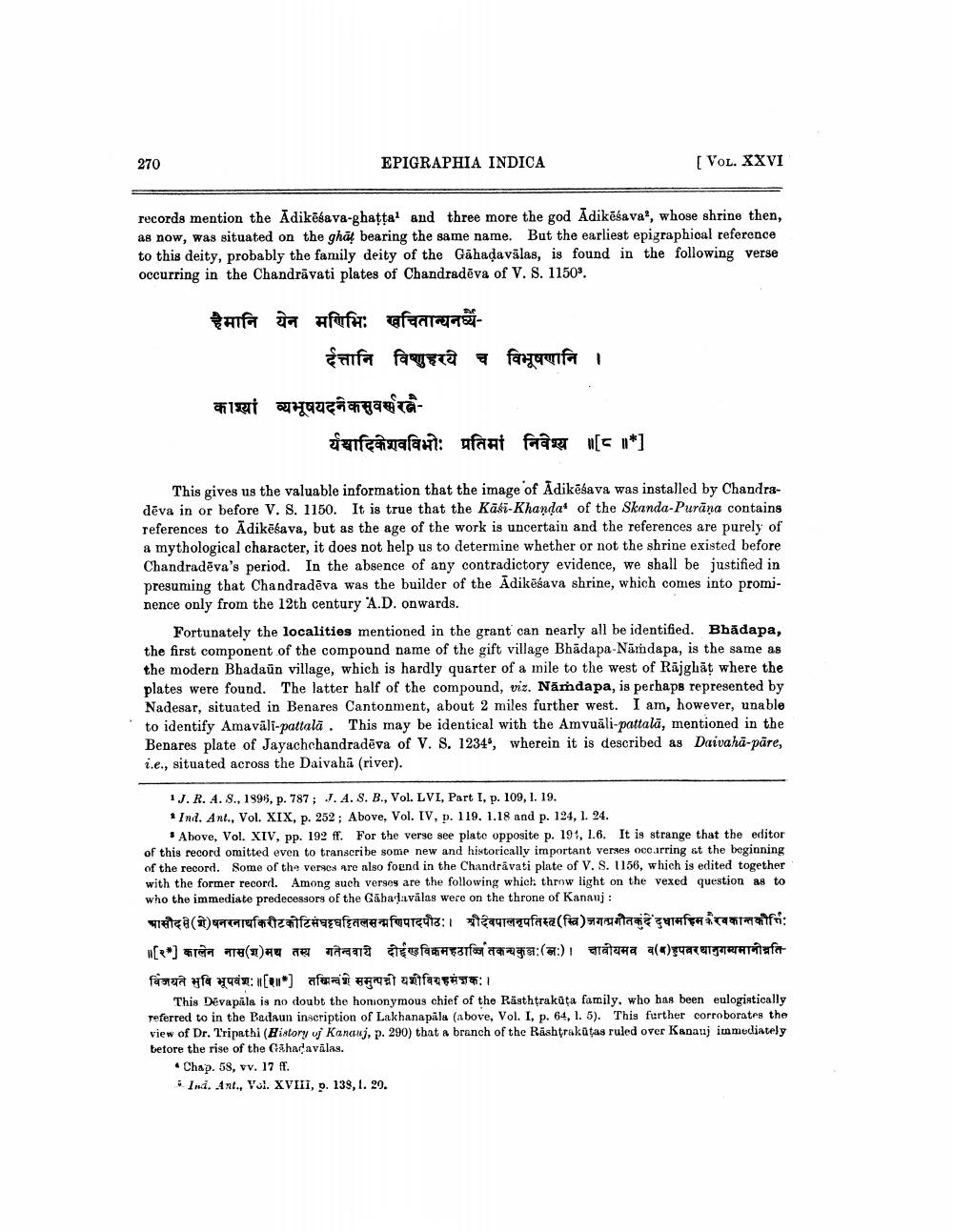________________
270
EPIGRAPHIA INDICA
[Vol. XXVI
records mention the Adiköbava-ghatta' and three more the god Adikēšava", whose shrine then, as now, was situated on the ghäf bearing the same name. But the earliest epigraphioal reference to this deity, probably the family deity of the Gahadavālas, is found in the following verse occurring in the Chandrävati plates of Chandradēva of V. S. 1150%.
हैमानि येन मणिभिः खचितान्यनये
दत्तानि विष्णुहरये च विभूषणानि ।
काश्यां व्यभूषयदनकसुवर्सरब
fuifcagafaut: afat farag
[
1*]
This gives us the valuable information that the image of Adikēšava was installed by Chandradēva in or before V. S. 1150. It is true that the Kāsi-Khandat of the Skanda-Purāna contains references to Adikēšava, but as the age of the work is uncertain and the references are purely of a mythological character, it does not help us to determine whether or not the shrine existed before Chandradēva's period. In the absence of any contradictory evidence, we shall be justified in presuming that Chandradēva was the builder of the Adikēšava shrine, which comes into prominence only from the 12th century A.D. onwards.
Fortunately the localities mentioned in the grant can nearly all be identified. Bhädapa, the first component of the compound name of the gift village Bhädapa-Närdapa, is the same as the modern Bhadaün village, which is hardly quarter of a mile to the west of Rajghat where the plates were found. The latter half of the compound, viz. Nämdapa, is perhaps represented by Nadesar, situated in Benares Cantonment, about 2 miles further west. I am, however, unable to identify Amaväli-pattala . This may be identical with the Amvuāli-pattalā, mentioned in the Benares plate of Jayachchandradeva of V. S. 1234", wherein it is described as Daivahā-pare, i.e., situated across the Daivaha (river).
1J.R.A.S., 1995, p. 787; J. A. S. B., Vol. LVI, Part I, p. 109, 1. 19. * Ind. Ant., Vol. XIX, p. 252; Above, Vol. IV, p. 119. 1.18 and p. 124, 1. 24.
. Above, Vol. XIV, pp. 192 ff. For the verse see plate opposite p. 191, 1.6. It is strange that the editor of this record omitted even to transcribe some new and historically important verses occurring at the beginning of the record. Some of the verses are also found in the Chandravati plate of V. S. 1156, which is edited together with the former record. Among such verses are the following which throw light on the vexed question as to who the immediate predecessors of the Gabarlavālas were on the throne of Kananj:
भासौद(शे)षनरनाथकिरीटकोटिसंघट्टितलसन्मणिपादपीठः। प्रौदेवपालनृपतिस्त (स्वि)जगत्प्रगौतकुंदेंदुधामहिम करवकान्तकौति: ॥[२१] कालेन नास(श)मथ तस्य गतेन्ववाये दोईण्डविक्रमहठाजितकन्यकुञ्जः (मः)। क्षाबीयमव ब(ब)हुपवर थानुगम्यमानीनति विजयते भुवि भूपवंशः ॥[*] तस्मिन्वंशे समुत्पन्नी यशोविग्रहमंज्ञकः ।
This Dévapila is no doubt the honionymous chief of the Rästhtrakūta family, who has been eulogistically referred to in the Badaun inscription of Lakhanapala (above, Vol. I, p. 64, 1. 5). This further corroborates the view of Dr. Tripathi (Ristory w Kananj, p. 290) that a branch of the Rashtraktas ruled over Kananj immediately before the rise of the Gahadavalas.
. Chap. 58, vv. 17 ff.
Ini. Ant., Vol. XVIII, p. 139, 1. 20.




